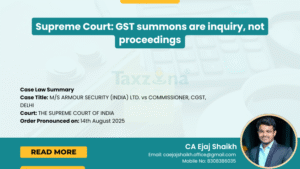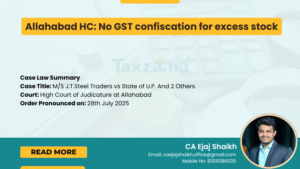Overview of GST Registration
GST was implemented in India with the intention of replacing many indirect taxes with a unified one. In addition to improving efficiency, GST facilitates collection due to its relatively simple nature.
Businesses with a yearly gross sales revenue of more than Rs. 40 lakhs* are needed to register for Goods and Services Tax (Rs 20 lakhs for North Eastern – All hilly states for sale of goods). If a service provider’s annual revenue is beyond Rs.20 lakh (for regular category states) or Rs.10 lakh (for special category states), they are required by law to register as a business (for special category states).
When the following conditions are met, GST registration is obligatory: –
- Passed a critical point in terms of total sales volume.
- Compulsory Registration is obligatory for some types of enterprises.
- Registering is completely optional.
All indirect taxes imposed by the federal government and state governments in India prior to the implementation of the Products and Services Tax (GST) are now included in the final sale price of all goods and services. {Pro Tip: gst return filing in mumbai}
What are the Benefits of GST Registration?
Listed below are a few of the many benefits of registering for GST: –
- Simplifies Taxation Services
Through the implementation of GST, the many indirect taxes in India have been consolidated into a single system, which has helped to further integrate the economy.
- Reduction In Costs Of Products & Services
The implementation of GST has reduced prices for consumers by eliminating the domino effect caused by many value-added taxes and VATs.
- Helps In Avoiding Lengthy Taxation Services
In order to speed up the taxes process, small companies might benefit from registering for GST. For this reason, the GST is not required to be paid by service providers with an annual revenue of less than 20 lakhs and by product suppliers with an annual revenue of less than 40 lakhs.
- Aimed At Reducing Corruption And Sales Without Receipts
One of the goals of implementing GST was to cut down on shady dealings and cash transactions. It also aids in lowering the burden of different indirect tax compliance for small businesses.
- Uniformity In Taxation Process
Uniformity in the taxing process and the ability to centralize registration are two benefits of the Goods and Services Tax (GST) Registration. It facilitates quarterly tax return filing for enterprises.
- Minimizing Tax Evasion
The implementation of GST has significantly reduced tax avoidance.
- Higher Threshold For Registration
Any Indian company with a revenue of more than Rs 5 lakh was required to pay value-added tax (VAT) under the old VAT regime. In addition, service providers with a revenue of less than Rs 10 lakh were excused from paying service tax. However, under the GST system, this barrier has been raised to Rs 20 lakh, meaning that many small businesses no longer have to pay GST.
- Composition Scheme For Small Businesses
Composition plan under GST allows businesses with a taxable income of between Rs 20 and Rs 75 lakh to pay less taxes. Numerous small firms have benefited from the reduced tax and regulatory burden brought on by this change.
- Simple And Easy Online Procedure
Everything related to Goods and Services Tax (GST), from initial registration to submitting tax reports, may be completed entirely online. This is especially helpful for new businesses since it streamlines the process of registering for taxes including value-added tax, excise tax, and service tax. GST Registration Services India: A Guide To GST will help you to understand in depth.
- Compliances Is Lesser In Number
Taxes on goods and services used to be handled separately, with separate filing requirements and reporting processes. However, under GST, just a single return is required.
- Regulations Of Unorganized Sector
Several sectors of India’s economy, including construction and textiles, were widely noted as being disorganized and poorly regulated prior to the implementation of the Goods and Services Tax (Online GST Registration). However, the Goods and Services Tax (GST) system allows for electronic filings and payments and permits input credit only once the provider has received the amount. As a result, these fields are now subject to oversight and control.
What are the turnover Criteria for GST Registration?
Individuals and businesses that fall within the categories below must register for GST.
- Any company with a yearly revenue of exceeding Rs. 40 million (Rs 20 lakhs for special category states in GST).
- Note-This provision does not apply if the entity is exclusively engaged in the supply of products and/or services that are exempt under GST, Every entity who is registered under a previous law of taxation (i.e., Excise, VAT, Service Tax, etc.) must get register under Goods and Service Tax.
- Anyone or any business that transports items over state lines.
- Someone who owes taxes under the “reverse charge” system
- Distributor and/or agent providing input services* Electronic commerce provider or aggregator* Taxable non-resident
- The Representatives of a Supplier through an E-Commerce Aggregator.
- Providers of online information, database acquisition, or retrieval services from a location outside India to a resident of India who is not a registered taxable person in India.
What are the Modes of GST in India?
Each level of government (Central and State) is responsible for imposing and collecting GST according to their own laws, which is why this model was chosen for GST administration. Here are the many GST delivery methods: –
- Central GST
The Central Government levies a levy called Central Goods and Services Tax (CGST) on transactions between states. It is called an intra-state supply of products or services when both the vendor and the purchaser are located inside the same state. Here, a vendor must collect two different types of sales tax: central goods and services tax (CGST) and state goods and services tax (SGST), both of which are retained by their respective governments.
- State GST
The State Goods and Services Tax (SGST) is a kind of sales tax charged by individual states on transactions occurring within the same state.
- Integrated GST
The IGST Act specifies the procedures for implementing integrated GST, including the seller’s obligation to collect IGST from the purchaser and the subsequent distribution of these funds to the Central and State Governments.
- Union Territory GST
Any purchases made or services rendered in the Indian Union Territories (UTs) are subject to the Goods and Services Tax (GST) and its associated revenue collection by the respective UT administration.

What Documents are required for GST Registration?
In order to complete your Online GST Registration, you will need certain papers that are industry-specific. You may see below the lists of papers needed for GST Registration (depending on the kind of business): –
For A Sole Proprietorship Business
- A copy of the owner’s PAN card
- The owner’s Aadhar number
- Posing with the owner’s portrait (in JPEG format, maximum size – 100 KB)
- Financial information
- Proof of Address
For A Partnership Firm
- PAN card of all partners (including managing partner and authorized signatory)
- Copy of partnership deed
- Photograph of all partners and authorized signatories (in JPEG format, maximum size – 100 KB)
- Address proof of partners (Passport, driving license, Voters identity card, Aadhar card etc.)
- Aadhar card of authorized signatory
- Proof of appointment of authorized signatory
- In the case of LLP, registration certificate / Board resolution of LLP
- Bank account details
- Address proof of principal place of business
For A HUF
- PAN Card of HUF and the Passport size Photograph of the Karta.
- Id and Address Proof of Karta and Address proof of the place of business.
- Bank Account Details
For A Public or Private Limited Company
- Pan card of the Company
- Certificate of incorporation of Company
- MOA and AOA of the company.
- Identity Proof and address proof of all directors and Authorized signatory of the Company.
- Passport size photograph of the directors and authorized signatory.
- Copy of Board resolution passed for appointing authorized signatory.
- Details of Bank account opening.
- Address proof of the place of business.
What is the Procedure for GST Registration Process in India?
- Step – 1
- Step-2
- Step – 3
- Step – 4
-
- Select ‘Taxpayer’ under the drop-down menu.
- Select the respective state and district.
- Enter the details of the business (Name and PAN card).
- Provide the email ID and mobile number (that must be active as OTPs will be sent on the details) in the respective boxes.
- Enter the Captcha shown on the screen and click on ‘Proceed’.
- Step – 5
- Step – 6
- Step – 7
- Step – 8
- Step – 9
- Step – 10
- Step – 11
- Step – 12
- Step – 13
- Step – 14
- Step – 15
- Electronic Verification Code (EVC).
- By the e-Sign method.
- In case the applicant is a company, the application must be submitted by using the Digital Signature Certificate (DSC).
- Step – 16
- Step – 17
What are the Penalties in Case of Non-Compliance in GST?
Late Fees for GSTR-3B
Currently Late fees is Rs. 20 (10 CGST & 10 SGST) for 3B filing per day for NIL returns and Rs. 50 (25 CGST & 25 SGST) in other than Nil. when there is no sale and no purchase it is called as Nil Return. Maximum penalty for this will be Rs. 10,000 (Rs. 5,000 for CGST and Rs. 5,000 for SGST) Per return.
This penalty will be charged and required to be paid in the next subsequent return and without which your next return won’t be accepted.
Late Fees for GSTR-1
Rs.200 per day (100 CGST and 100 SGST).Currently Department is accepting GSTR-1 without the payment of this late fees.
Late Fees for GSTR-9 and GSTR-9A
Rs. 200 (Rs. 100 for CGST and Rs. 100 for SGST) per day . However maximum cap for this late fees is 0.50% of the turnover.
Late Fees for GSTR-10
LRs. 200 (Rs. 100 for CGST and Rs. 100 for SGST) per day. Maximum late fees is Rs.10,000/- for this return.
What is the Validity of GST Registration Certificate?
Any certificate of GST registration is valid only for the specific kind of taxpayer for whom it was issued. When given to an ordinary taxpayer, the certificate remains in effect permanently. Only if the GST authority cancels it or the taxpayer hands it in does it become invalid in such a circumstance.
Certificates issued for the casual taxpayer or the Non-Resident Indian (NRI) taxpayer are only valid for 90 days from the date of registration or for the term mentioned in the registration application, whichever comes first. Authorities are able to prolong the duration of validity if necessary under Section 27(1) of the GST Act.
How an Applicant will get the GST Registration Certificate Online?
- When the ARN has been created, the applicant must next go to the GST site.
- To access their own GST account, each applicant must provide their unique login and password. In addition, a candidate must enter the correct captcha into the box and then click the login button.
- To access the “View/Download Certificates” option, an applicant must first pick “User services” from the “Services” drop-down menu.
- If you want to download the registration certificate, the process will begin immediately.
- Anyone who requires a GST Certificate may get one by going to the GST common site (which can be found at https://www.gst.gov.in).




